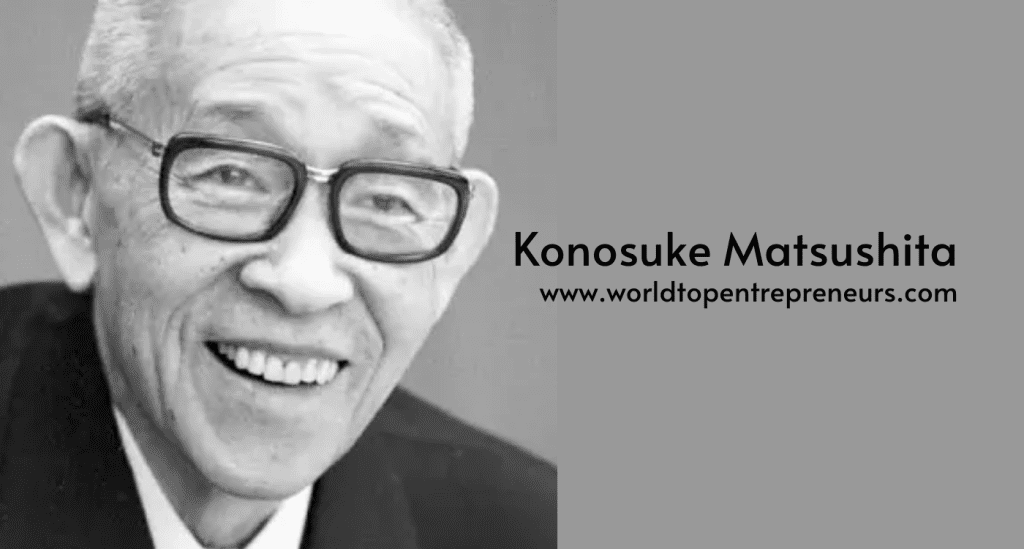Konosuke Matsushita is a name that resonates with innovation, entrepreneurship, and the spirit of Japanese manufacturing excellence. As the founder of Panasonic Corporation, Matsushita’s journey from modest beginnings to establishing a global electronics empire is a remarkable story of vision, resilience, and leadership. This article explores Matsushita’s early life, his founding of Panasonic, his leadership philosophy, and his lasting impact on the electronics industry.
Early Life and Education
Konosuke Matsushita was born on November 27, 1894, in Osaka, Japan, into a family of modest means. His early years were marked by economic hardship, which profoundly influenced his character and future ambitions. Matsushita’s upbringing in a poor household provided him with a firsthand understanding of the struggles faced by ordinary people, instilling in him a strong work ethic and a determination to succeed.
Matsushita’s formal education was limited; he completed his schooling at a young age and started working to support his family. His early jobs exposed him to the world of commerce and manufacturing, experiences that would later inform his approach to business. Despite his lack of formal higher education, Matsushita’s curiosity and drive for learning fueled his future successes.
The Birth of Panasonic
The story of Panasonic Corporation began in 1918, when Konosuke Matsushita founded the Matsushita Electric Housewares Manufacturing Works in his small apartment. With an initial investment of just 100 yen (a modest sum by today’s standards), Matsushita set out to create electrical appliances that were affordable and reliable. His first product was a socket for electric light bulbs, which laid the foundation for his future endeavors.
In the early years, Matsushita faced numerous challenges. The company struggled with limited resources, competition, and the need to establish a market presence. However, Matsushita’s relentless determination and innovative thinking played a crucial role in overcoming these obstacles. His focus on producing high-quality products at competitive prices resonated with consumers, helping to establish the company’s reputation in the market.
Early Innovations and Growth
During the 1920s and 1930s, Matsushita Electric expanded its product range and began to gain traction in the Japanese market. The company introduced several innovative products that set new standards in the industry. One of the notable innovations was the development of the “National” brand, which became synonymous with reliability and quality.
1. The National Radio
One of Matsushita’s early successes was the introduction of the National radio. The radio was designed to be affordable and accessible to a wide audience, a reflection of Matsushita’s belief in making technology available to all. The National radio quickly became popular in Japan, contributing significantly to the company’s growth and establishing it as a key player in the electronics industry.
2. Expansion into New Markets
As Matsushita Electric continued to grow, Matsushita recognized the importance of expanding into new markets. The company ventured into the production of a wide range of electrical appliances, including refrigerators, washing machines, and televisions. This diversification helped to mitigate risks and capture a larger share of the market.
Matsushita’s strategy also involved investing in research and development to drive innovation. The company established its own research laboratories and focused on developing new technologies that could improve the performance and efficiency of its products. This emphasis on R&D played a crucial role in maintaining the company’s competitive edge and driving its growth.
Leadership Philosophy and Management Style
Konosuke Matsushita’s leadership philosophy was deeply rooted in his personal experiences and values. His approach to management was characterized by a strong emphasis on teamwork, employee welfare, and a commitment to customer satisfaction.
1. The Importance of Teamwork
Matsushita believed that the success of a company depended on the collective efforts of its employees. He fostered a collaborative work environment where employees were encouraged to share ideas, take initiative, and contribute to the company’s goals. Matsushita’s emphasis on teamwork and mutual respect helped to create a positive and productive workplace culture.
2. Employee Welfare and Development
Matsushita was also known for his commitment to employee welfare and development. He implemented policies that focused on the well-being of his employees, including fair wages, job security, and opportunities for professional growth. Matsushita believed that investing in employees was essential for the long-term success of the company.
3. Customer-Centric Approach
A key aspect of Matsushita’s leadership philosophy was his commitment to customer satisfaction. He believed that understanding and meeting the needs of customers was crucial for building a successful business. Matsushita encouraged his team to listen to customer feedback, continuously improve products, and deliver exceptional service.
Global Expansion and Transformation
By the mid-20th century, Matsushita Electric had established itself as a leading player in the Japanese market. However, Matsushita’s vision extended beyond national borders. He recognized the potential of global markets and sought to expand the company’s presence internationally.
1. Entering the U.S. Market
In the 1960s, Matsushita Electric made its first foray into the U.S. market. The company faced significant challenges in establishing a foothold in a highly competitive market dominated by American electronics firms. However, Matsushita’s strategy of offering high-quality products at competitive prices helped the company gain recognition and build a strong market presence.
The introduction of Panasonic as the company’s international brand played a crucial role in this expansion. The Panasonic brand became synonymous with innovation and reliability, helping to establish the company as a global leader in electronics.
2. Adapting to Market Trends
As the global electronics market evolved, Matsushita Electric adapted its strategy to stay ahead of industry trends. The company focused on emerging technologies such as digital electronics, home entertainment systems, and information technology. Matsushita’s ability to anticipate and respond to market changes contributed to its continued growth and success.
3. Mergers and Acquisitions
To strengthen its global position, Matsushita Electric engaged in strategic mergers and acquisitions. These moves helped the company expand its product portfolio, enter new markets, and enhance its technological capabilities. Notable acquisitions included companies in the consumer electronics, automotive, and industrial sectors.
The Legacy of Konosuke Matsushita
Konosuke Matsushita’s legacy extends far beyond the success of Panasonic Corporation. His contributions to the electronics industry and his leadership principles have had a lasting impact on the business world.
1. Innovation and Excellence
Matsushita’s emphasis on innovation and excellence has become a cornerstone of Panasonic’s success. The company’s commitment to developing cutting-edge technologies and delivering high-quality products reflects Matsushita’s vision and values. Panasonic’s continued success as a global electronics leader is a testament to the enduring influence of Matsushita’s innovative spirit.
2. Leadership and Management Philosophy
Matsushita’s leadership philosophy has inspired countless business leaders and managers. His emphasis on teamwork, employee welfare, and customer satisfaction has become a model for effective management practices. Many companies have adopted Matsushita’s principles to create positive workplace cultures and achieve long-term success.
3. Philanthropy and Social Responsibility
Matsushita’s commitment to philanthropy and social responsibility was evident throughout his life. He supported various charitable initiatives and social causes, including education, healthcare, and disaster relief. Matsushita’s legacy includes a strong commitment to making a positive impact on society and contributing to the greater good.
Reflections on Konosuke Matsushita’s Impact
Konosuke Matsushita’s journey from a young entrepreneur with a modest start to the founder of a global electronics powerhouse is a remarkable story of vision, resilience, and leadership. His contributions to the electronics industry have left an indelible mark on the world, shaping the way technology is developed and delivered.
Matsushita’s approach to business, characterized by a focus on innovation, teamwork, and customer satisfaction, has set a high standard for the industry. His ability to navigate challenges, adapt to changing markets, and drive global expansion is a testament to his strategic acumen and leadership qualities.
Furthermore, Matsushita’s commitment to philanthropy and social responsibility reflects his belief in the importance of giving back to society. His legacy serves as an inspiring example of how businesses can achieve success while making a positive impact on the world.
Conclusion
Konosuke Matsushita’s legacy as the founder of Panasonic Corporation is a testament to the power of vision, innovation, and leadership. His journey from humble beginnings to establishing a global electronics empire is a remarkable story of perseverance and determination.
Through his leadership, Matsushita transformed Panasonic into a leading player in the electronics industry, known for its innovative products and commitment to quality. His principles of teamwork, employee welfare, and customer satisfaction continue to inspire business leaders and managers around the world.
Konosuke Matsushita’s impact extends beyond the success of Panasonic Corporation. His contributions to the electronics industry, his leadership philosophy, and his commitment to philanthropy have left a lasting legacy that continues to shape the business world and inspire future generations.





















